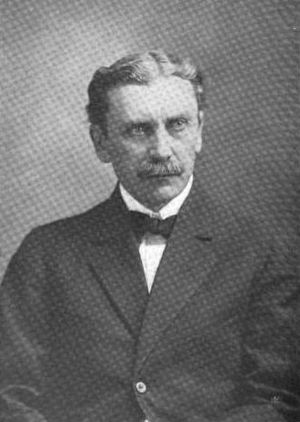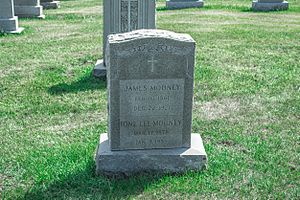James Mooney facts for kids
James Mooney (born February 10, 1861 – died December 22, 1921) was an American ethnographer. An ethnographer studies different cultures and peoples. Mooney lived for many years among the Cherokee people. He was known as "The Indian Man."
He carried out important studies of Native American tribes in the Southeastern United States and on the Great Plains. After Sitting Bull's death in 1890, Mooney studied the Ghost Dance. This was a spiritual movement among various Native American groups.
His books about the Cherokee include The Sacred Formulas of the Cherokees (1891) and Myths of the Cherokee (1900). The US Bureau of American Ethnology, part of the Smithsonian Institution, published all his works.
Mooney collected many Native American artifacts. These are now kept at the National Museum of Natural History and the Field Museum of Natural History. His papers and photographs are at the National Anthropological Archives.
Contents
Early Life and Learning
James Mooney was born on February 10, 1861. This was in Richmond, Indiana. His parents were Irish Catholic immigrants. He went to public schools in his city.
Mooney became an expert on American tribes by teaching himself. He studied a lot and carefully observed different groups. He lived with them for long periods. Ethnography was a new field in the late 1800s. Mooney helped set high standards for this type of work.
Starting His Career
In 1885, Mooney began working for the Bureau of American Ethnology. This bureau is now part of the Smithsonian Institution in Washington, D.C.. He worked under John Wesley Powell.
Mooney created a list of Native American tribes. This list included 3,000 names. His work was very important. After the US Army's 1890 conflict with the Lakota people at Wounded Knee, South Dakota, Mooney became a national expert. He was recognized for his knowledge of American Indians.
Mooney's Writing Style
People thought Mooney's writing was very descriptive. He wrote about Native Americans with understanding. This was likely because of his own background. He wrote like a scientist, aiming to be objective.
His fair view of Native Americans was different from other writers. Many others wrote about Native Americans in a romantic or unfair way. Mooney generally agreed with the idea of Native Americans joining mainstream society. However, he also saw the difficulties this caused for traditional peoples. He reported on these issues and changes in a very factual way.
During the late 1800s, Native Americans faced many challenges. They often lost their lands and traditional ways of life. Conflicts, sometimes called the Indian Wars, happened. These were often presented as necessary because of Native American attacks. Mooney wrote more objectively about these events in the West.
Mooney took time to observe different Native American tribes. He saw how they lived every day. Before his work, most people outside reservations learned about these issues from far away. He wanted to learn and teach other Americans about Native American cultures. He published several books based on his studies.
The Ghost-dance Religion and the Sioux Outbreak of 1890
Mooney's book starts with a history of similar spiritual movements. These movements happened among other American Indian groups. The Ghost Dance quickly spread among tribes in the western United States in the early 1890s. Mooney wanted to describe and understand this movement.
He visited Wovoka, the Ghost Dance prophet, in his home in Nevada. Mooney also tracked how the Ghost Dance moved from place to place. He described the rituals and wrote down the unique song lyrics from seven different tribes.
Calendar History of the Kiowa Indians (1898)
Mooney believed that people naturally want to remember past achievements. He said that how reliable a record is depends on the truthfulness of the person recording it. It also depends on how well they record it. Mooney earned the trust of the Kiowa people.
The Kiowa told him about their calendar system. They used it to record important events. They said the first calendar keeper was Little Bluff, or Tohausan. He was the main chief from 1833 to 1866. Mooney also worked with two other calendar keepers. These were Settan (Little Bear) and Ankopaingyadete (In the Middle of Many Tracks), also known as Anko.
Other Plains tribes also kept picture records. These are called winter counts. They were usually made in the winter when people stayed indoors. They showed major events of the year. The Kiowa recorded two events each year. This gave them a more detailed record. Silver Horn (1860–1940) was a highly respected Kiowa artist. He also kept a calendar. He became a respected religious leader later in his life.
Myths of the Cherokee (1900)
Mooney spent a lot of time with the Cherokee people. By then, many had moved to Indian Territory. This area is now part of Oklahoma and North Carolina. For many years, he worked with Eastern Band of Cherokee Indians elder and translator Will West Long.
Mooney studied their language, culture, and stories. This large book collected 126 Cherokee myths. These included sacred stories, animal myths, local legends, and historical traditions. Some of the myths were:
- How the World was Made
- Why the Deer's Teeth are Blunt
- How the Turkey got his Beard
- Why the Possum's Tail is Bare
The book also has original Cherokee writings. These relate to their history, old sites, place names, personal names, plants, medicine, arts, home life, religion, songs, ceremonies, and language.
Historical Sketch of the Cherokee (1975)
This book was published after Mooney's death. It tells the story of the Cherokee people. It starts from their first contact with white settlers. It covers battles, treaties that were broken, towns destroyed, and people harmed. The story ends around 1900.
Mooney wrote that the history of the Cherokee shows both kindness and cruelty. It also shows their strength and determination. This is balanced with disappointment and frustration. He believed the Cherokee's experience was similar to that of most Native Americans. This book, like most of Mooney's works, is seen as fair and factual. This is why his works are found in the Bureau of American Ethnology.
Later Life and Death
James Mooney married Ione Lee Gaut on September 28, 1897. They married in Washington, D.C. They had six children. One of their sons was the writer Paul Mooney.
James Mooney died from heart disease in Washington, D.C. on December 22, 1921. He was buried in Mount Olivet Cemetery in Washington, D.C.
See also
 In Spanish: James Mooney para niños
In Spanish: James Mooney para niños



